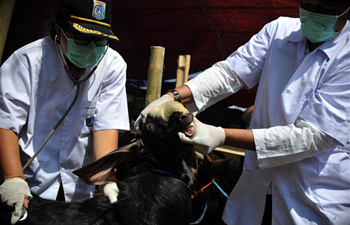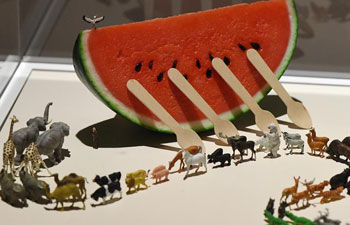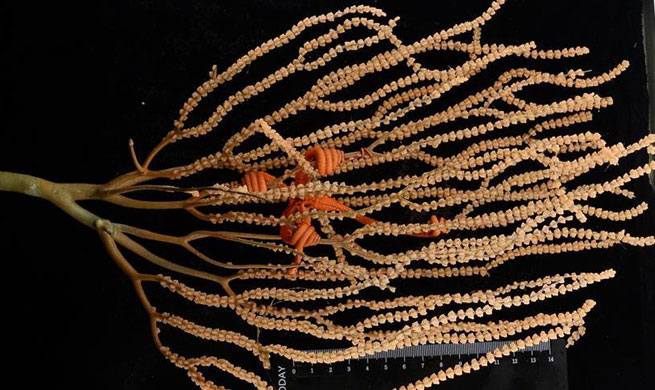by Peter Mutai
NAIROBI, Aug. 24 (Xinhua) -- The Mbita causeway that provides a strategic linkage between communities living in Rusinga Island in Western Kenya has stood out as an architectural wonder for decades.
It was constructed in the early 1980s to link Rusinga Island to the mainland and facilitate movement of people, goods and services.
However, its construction was carried out without adequate consultations with environmentalist and marine experts who over the years have blamed it for the dwindling stock of fish in the Winam Gulf located at the heart of Lake Victoria.
A recent interview conducted by Xinhua along the lake revealed that fish stock is fast increasing in the Gulf since the removal of the causeway two months ago.
"The black water current is freely flowing towards the gulf for the first time in many years," said Gideon Nyaidho, a fishery Assistant with the Department of Fisheries in charge of East Karachuonyo.
He noted the water within the Gulf is currently hot and lots of fish are migrating to the side to hatch, a development that is new to the fisheries fraternity.
In the early 1990s, researchers at the Lake Victoria Environment Management Program (LVEMP) and Kenya Marine and Fisheries Research Institute (KEMFRI) did a study that found that the causeway has poor water quality, blockage of fish migration and interference with breeding patterns.
Political leaders too blamed the existence of the causeway to the miseries that the fisher folk aced in carrying out their trade.
Overtime, scientists have piled pressure on the government to remove the causeway, which they claimed blocked the free flow of water across the lake, resulting in the near-death of one side of Winam Gulf.
As the flow of water remained blocked, the Gulf developed into a fertile breeding ground for the dreaded invasive water hyacinth that has been choking a huge swathe of Lake Victoria for two decades.
The government yielded to pressure and a demolition exercise commenced in earnest four years ago and has yielded a new fly-over bridge that allows water to pass under it freely towards the Gulf.
Nyaidho noted that the Gulf has since reclaimed its hatching ground prowess, a position it held since the early 1950s going by the latest activities along the beaches on the side of the lake.
"We have to intensify surveillance to help protect the region from unscrupulous fishermen by ensuring that only fishermen who are using recommended gears fish in the area," Nyaidho noted.
He told communities along the Gulf to be on the look out to ensure that fishermen use the rightgears and fish at specified period of time.
James Kingi, a fisherman along Siala beach, confirmed that fishing activity has started improving by the size of fish that are being caught.
Kingi who has been fishing for the past 20 years said that the current development is indeed good news to them as the fish on the Gulf side almost got finished due to poor re-stocking from the southern side of the lake.
Fredrick Juma, a Fishery Assistant in West Karachuonyo, observed that the riverine fish species were eliminated as there was no access to the deep waters.
He added that as rivers empty their contents, sometimes raw sewerage wastes from towns and agricultural plantations, the water became shallow and toxic to marine life.
"The Causeway permanently blocked a secondary connection between Rusinga Channel and the offshore waters of Lake Victoria towards the gulf, hence poor stocking of fish on the side," he added.
An environmentalist with Friends of Lake Victoria (OSIENALA), an environmental watchdog within the lake, Peter Mireri, noted that the channel which is 250 meters in length and over 10 meters in depth was blocked by the causeway, hence reducing the lake's cleansing capacity.
He said that fishing activity had reduced on the side due to lack of flushing and exchange of water between the two shores.
"I welcome the demolition and the construction of the new bridge as a good gesture for the fisherfolk and the ecosystem of the lake," Mireri added.
Mireri revealed that despite destroying fish breeding grounds, the Mbita channel also had hampered shipping trade within the gulf.
According to Nyaidho, even though the channel had been a stumbling block to the fishing industry in the region, water hyacinth has equally caused headache to fishers.
But he said that the introduction of beetles is immensely contributing to the demise of the weed since the blanket-thick weed that has been eaten by the insects are fast sinking, hence paving way for hippo grass that attracts fish to grow with ease.
"The rotting hyacinth is creating some black mud that is today home to mud fish and cat fish, popular delicacies with the locals," he added.
He however noted that daily catch of tilapia and Nile perch has dropped drastically due to the high demand of the two species.
"With the construction of the fly over bridge and proper patrol of the lake, I can see fishing activity booming once again as was the case in the 60s and 70s," Nyaidho added.
The 200-meter bridge that links Rusinga Island and Mbita mainland in Suba District Western Kenya, commissioned two months ago, was built at a cost of about 10.5 million dollars.

















